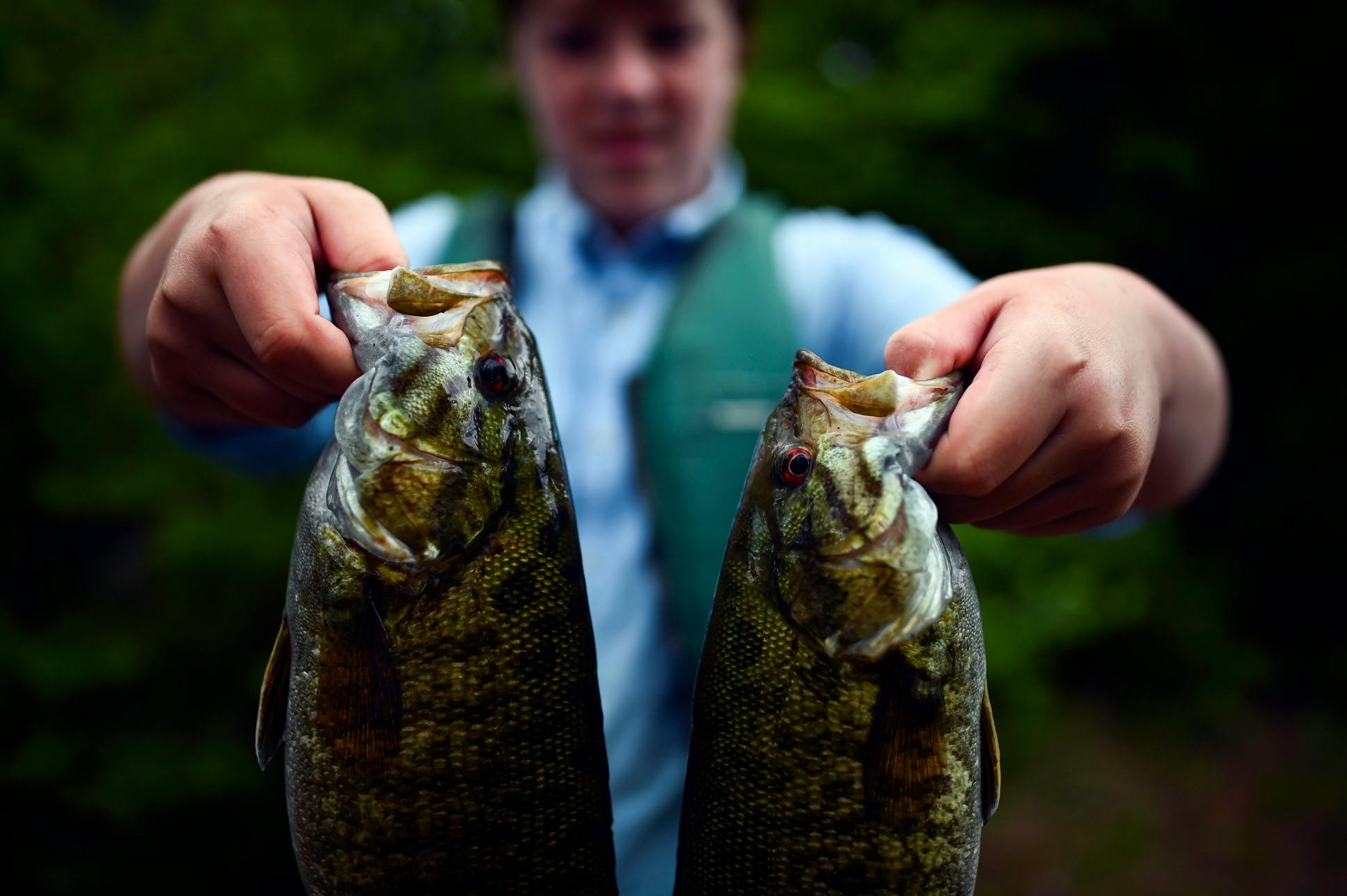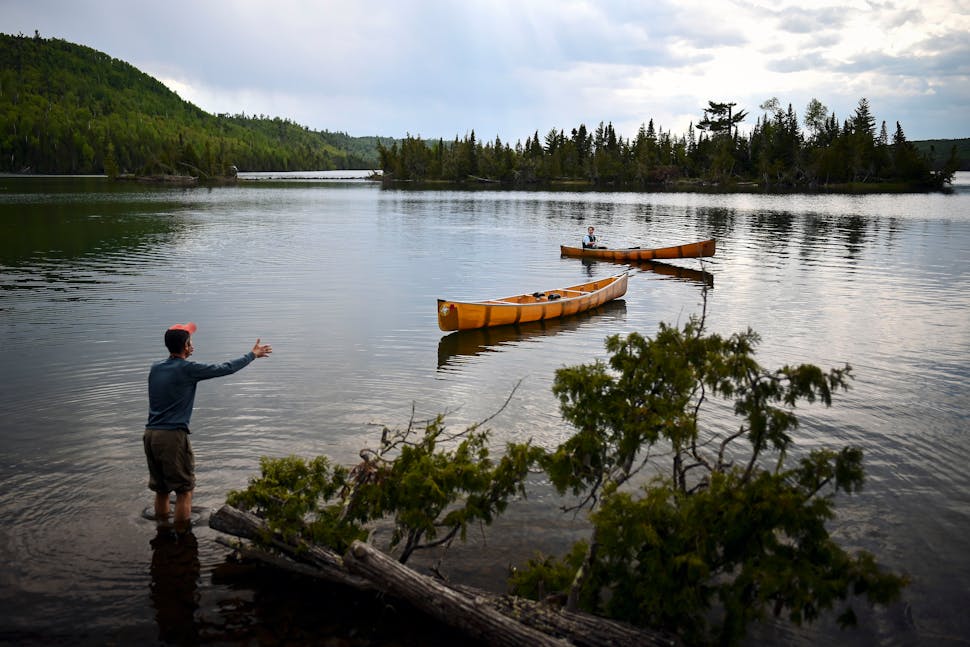Father, son launch epic Boundary Waters canoe journey
THE SERIES
The morning hung still and warm as our group of five eased two canoes into Gunflint Lake. In the bow of my boat sat my youngest son, Aidan, and I wondered if he really grasped what lay in front of him. We'd been on this northern Minnesota border lake once before, when he was 5. I was mid-divorce, and I stole away with Aidan and his brother and sister for a weekend at Gunflint Lodge; Aidan caught a big lake trout during our four-hour boat rental, a good memory from an otherwise trying time.
Now 14, Aidan pulled his paddle through the water.
"Drop your bottom hand lower," I told him, "and you'll get more power in your stroke." I hoped to make new memories with my son on this trip, to baptize him into the wild beauty that is the Boundary Waters Canoe Area Wilderness (BWCA).
Like so many Minnesotans, my first visit to the BWCA came when I was Aidan's age. Some arrive with the YMCA or a Scout troop; I came with a half-dozen kids from my church youth group. My first distinct memory of that trip is our pastor chugging an entire bottle of Pepto Bismol before we set out, steeling himself against the perils of lake water and camp food. The second memory is that on our last night, one of us asked him why he hadn't led any daily devotions. Sweeping his arm across lake and forest, he said, "I figured that surrounded by this beauty, you'd be in a constant state of devotion."
Thereafter, adulthood intervened: college, graduate school, marriage and family, and work. Life conspired to keep me away from the BWCA, until a half-dozen years ago, when I committed to coming back annually for as long as I'm able. Each of those trips has been memorable, but paddling with my teenage son promised something special: shared experiences during the period when kids naturally pull away from their parents.
We'd be paddling a portion of the "Voyageur's Highway," the route from Rainy Lake to Lake Superior along the Minnesota-Ontario, Canada, border named for the French-Canadian paddlers who navigated it — with their fur hauls — from the 1730s to the 1850s. The voyageurs were only one wave of humans to ply these waters and portages, preceded by the Ojibwe and succeeded first by lumberjacks and ultimately by recreational canoeists like us. From Gunflint Lake, we'd travel southeast, toward the Big Lake, as the voyageurs had each spring, their canoes weighed down with beaver pelts and other furs bound for Europe.
Helming the other canoe was Brad Shannon, a longtime friend, who lives in Grand Marais. When we were younger men, Brad and I had spent a summer together in Ciudad Juárez, Mexico, mixing concrete in wheelbarrows in stifling heat, building cinder block homes in the place of cardboard shanties. I'd lost touch with Brad for years, only reconnecting with him when I heard he was guiding trips in the BWCA. Now he's a guidance counselor at Cook County High School, but his expertise at canoeing and camping has not waned.
Two Star Tribune journalists joined Brad in his canoe: Outdoors Weekend editor Bob Timmons and photographer Aaron Lavinsky. Both are professionally and personally involved in exploring the outdoors, and both were making their second visit to the BWCA.
And then there was Crosby, my yellow Labrador retriever. His yearling body still bristles with puppy energy, and I carried some trepidation about how he would behave in a canoe for hours on end.
The adventure begins
After putting in at the public boat landing on the west side of Gunflint Lake, we paddled east. A staff member at Gunflint Lodge was filling a pontoon boat with gas, but it was still too early for any guests to be up and about. Placid water made paddling easy, and after a few miles, a gentle tailwind made it even easier.
"We could take out my hammock and use it as a sail," Aidan said over his shoulder.
"I seem to remember that the voyageurs did that on occasion," I replied. "Keep paddling."
The calm day offered us a gentle entry into this five-day/four-night adventure, but I knew it was a chimera. Ahead of us blew headwinds of various sorts.
As we paddled away from Gunflint Lodge, its pontoon boats and electricity and toilets represented all that we were leaving behind. Modern life places a premium on comfort and convenience. Whether it's the mattress that promises the perfect night's sleep, the car that bathes us in stereophonic sound, or the coffeemaker that pours the perfect cup every time, we are enveloped in comfort, at least relative to generations of humans who've preceded us on this planet.
The voyageurs knew no such luxury, making the 250-mile journey in under a week. They woke at dawn and paddled hard — 40 strokes per minute, 50 minutes per hour — until a midmorning breakfast of pemmican, a proto-energy bar of dried buffalo meat, berries and lard. After a few more hours of paddling, they'd stop for lunch — pemmican, again. After making camp at dusk, they'd indulge on pea soup, a nip of rum, and maybe some fish. If the mosquitoes and black flies got really bad, they'd rub lard on themselves, which seems to have been more of a placebo than a bug repellent.
Although we had DEET and Kevlar canoes, I knew that we, too, were bound for discomfort. There'd be bugs and wind and waves and thunderstorms and rocky tent pads and sore shoulders and wet feet. And no cell coverage. These inconveniences keep a lot of people out of the BWCA, and I was anxious to see how my boy would respond to the inevitable adversity.
Departing the big water of Gunflint Lake, we paddled on its eastern shore into a creek that we thought was Little Gunflint Lake. Instead, we came to realize it was a backchannel into a marsh, but we were rewarded with a loon, statuesque on its nest. On our second attempt, we found the inlet to Little Gunflint and followed that into Little North Lake, both shallow with the occasional beaver dam.
A now stronger tailwind spit us into North Lake, halfway through our 15-mile day. Brad took a bearing on his compass and pointed us south, along the western shore, toward Height of Land Portage, our official entry point to the BWCA. An 80-rod portage, Height of Land is noteworthy because it stands on the Laurentian Divide — water to its north and west flows to Hudson Bay, and water to its south and east flows into Lake Superior and ultimately into the Atlantic Ocean. It's also where the voyageurs "baptized" neophytes and celebrated with copious amount of rum. You weren't called a voyageur until you'd been christened here.
When we disembarked under a hot midday sun, Aidan gamely hoisted a portage pack on his back, affixed his knapsack of fishing gear to his front, picked up paddles in one hand and a bucket of leeches in the other, and headed up the path. I strapped a saddlebag full of dog food over Crosby's back, lifted a canoe onto my shoulders and began the first of many portages.
At the other end of Height of Land Portage, we dropped our gear. With a spruce branch dipped in South Lake, I sprinkled Aidan and Crosby and welcomed them into the fraternity of voyageurs. We all took a sip of whiskey and set off into the million-acre wilderness.
Tony Jones is a freelance writer and theologian, and lives in Edina. Reach him at ReverendHunter.com.






